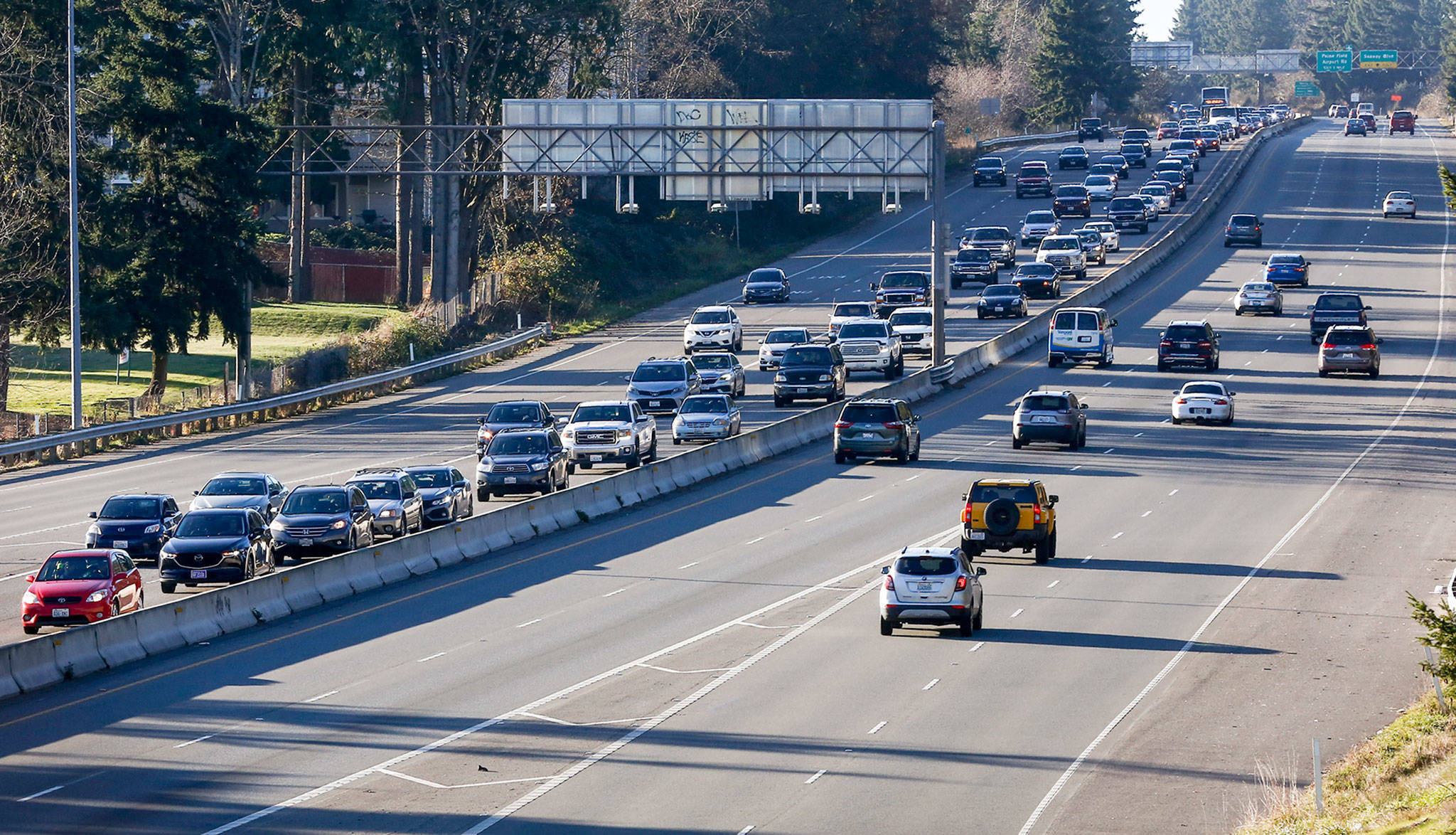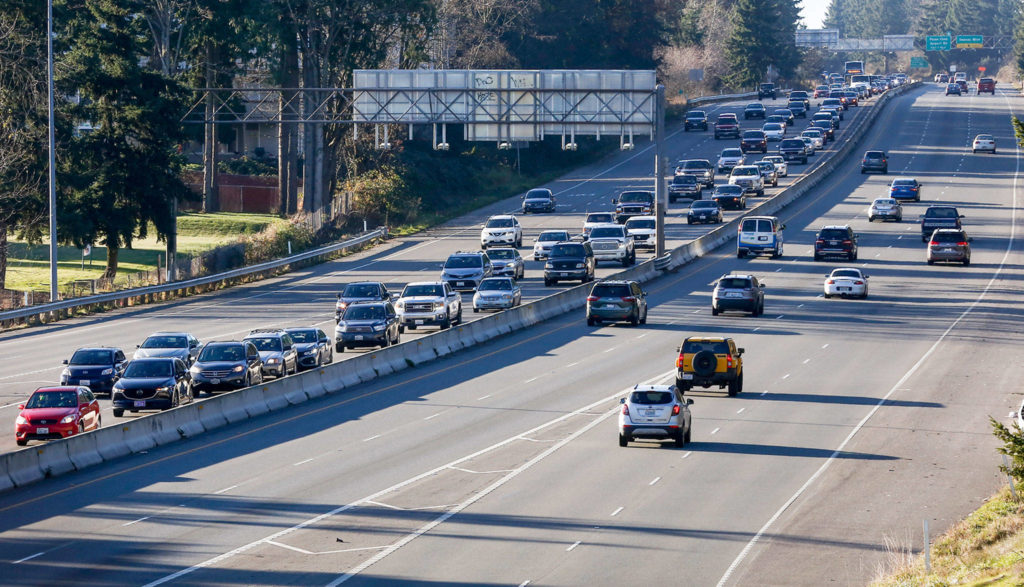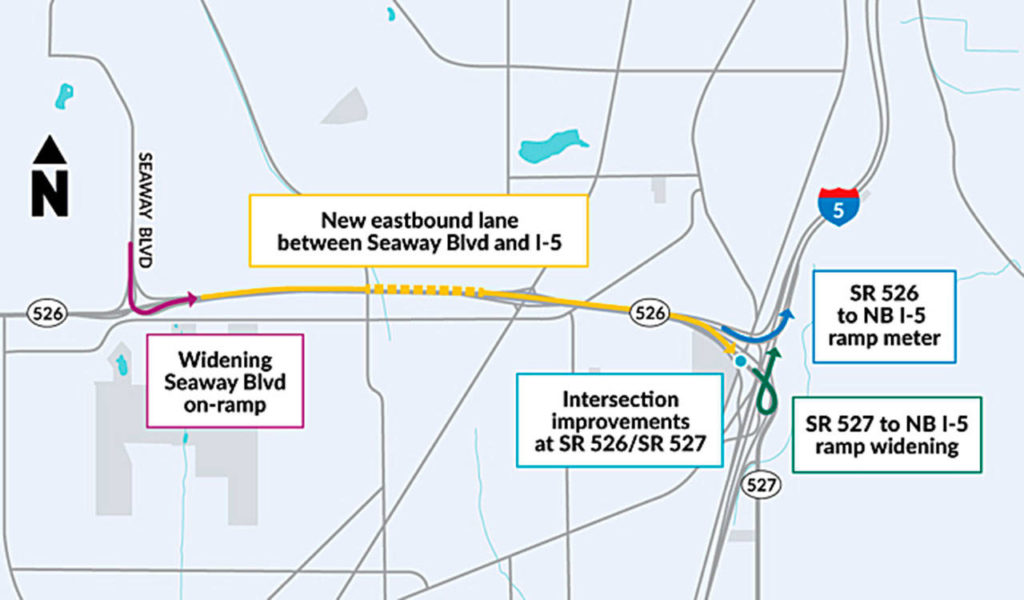Driving from Boeing to I-5 could get easier in the coming years.
The Washington State Department of Transportation is proposing an extra lane, ramp meter signals, improved off ramps and highway connections as remedies for weekday traffic woes along Highway 526. Ground work could begin between spring and summer of 2022 and wrap toward the end of 2024. Over $47 million was budgeted for the design and construction in the 2015 legislative funding called Connecting Washington, a $16 billion package.
WSDOT has an online open house for people to learn about and comment on the project through Friday.
Before the pandemic stymied commuting, WSDOT estimated 74,000 vehicles used the highway every day. Some of those drivers between Seaway Boulevard and Highway 527/Bothell-Everett Highway could see their travel times drop three to five minutes in the coming decades just in that stretch, WSDOT assistant project manager Masoud Kayanda said.
“It’s not just the time, but it’s the capacity that takes traffic out of city streets,” he said.
Thousands of people flood the highway every day to go to and from Boeing and other workplaces around Paine Field. The aerospace company is the runaway employment leader in Snohomish County with more than 35,000 workers in 2019, according to Economic Alliance Snohomish County. Providence Regional Medical Center Everett is second with more than 4,900 employees.
It yields the first weekday afternoon traffic peak, usually around 2 to 3 p.m., when schools in the area also send students home. A second traffic peak follows from 4 to 5 p.m., Kayanda said.
The City of Everett has supported highway improvements there for years, city traffic engineer Corey Hert said. Everett has backed the preferred alternative and any other projects that can alleviate the congestion through the city, including on busy Highway 99/Evergreen Way.
“With that improved capacity on Highway 526 comes some reduction of regional trips that come through Everett,” he said.
But with Boeing moving 787 work currently done at its Everett plant to facilities in South Carolina, there is uncertainty about its future employment numbers in the state.
The Paine Field area is a federally recognized opportunity zone with tax incentives for developing real estate and operating businesses. It’s attracted other employers, such as Amazon, which already have added traffic, Kayanda said.
“It’s going to take a lot of cutting from Boeing” to negate benefit from the state’s road project, he said.
State population projections still estimate between 130,000 and 300,000 more residents in Snohomish County by 2050, so WSDOT wants to prepare for traffic flow at one of the region’s major employment centers. In the coming years, that population growth is projected to add another 5,000 vehicles during peak afternoon hours between 2 and 5 p.m.
“We all know the area is growing,” Kayanda said. “So the key here is to increase capacity on 526. By doing so, we’re benefiting the local streets as well.”
Adding another eastbound lane from Seaway Boulevard to I-5 on the right side is expected to boost capacity for traffic. To do so, the state proposes shifting the existing lanes and the medians to create three general purpose lanes between 11 and 12 feet wide, the standard width.
Hert and others in Everett expect the added highway capacity will reduce congestion through Casino Road and Pecks Drive — east-west connections from Evergreen Way/Highway 99 toward Boeing that both pass school zones.
“Once that lane is added, it will help traffic in and out of the southwest Everett industrial area for the next 20 years,” Hert said.
Early in the design phase, transportation planners considered designating the new lane for high occupancy vehicles, but opted to keep it for general purpose to help traffic flows through the short stretch, Kayanda said.
At the eastern edge where Highway 526 crosses Everett Mall Way and shifts into Highway 526, the state-operated traffic signal is getting better timing. Instead of dedicating equal time to each direction, it will be programmed to move heavy volumes through the light longer and more frequently.
Where the highway’s elevated ramp dumps vehicles into northbound I-5 unimpeded now, ramp meter signals will control the flow. The light staggers incoming traffic between 4 and 15 seconds, which the state says improves merging and safety.
“Ramp meters are very effective at helping reduce collisions,” WSDOT spokesperson Kris Olsen said.
A case study by the Federal Highway Administration found that ramp meters break up waves of vehicles trying to merge and that “the opportunities for single cars to merge are better than for platoons to bull their way into traffic.”
That new ramp meter will make I-5 access uniform in Everett, as all of the other nearby northbound on-ramps have them. Ideally that means people won’t search for shortcuts on city streets, a possibility the state considered but eventually dismissed as unlikely.
“(Highway) 99 is so far away from I-5 once you get up in that area,” Olsen said.
Online open house
Learn about and comment on the WSDOT’s proposed projects for Highway 526 at https://bit.ly/33zn4gQ. The online open house is available for comment through Friday.
Have a question? Email streetsmarts@heraldnet.com. Please include your first and last name and city of residence.
Talk to us
> Give us your news tips.
> Send us a letter to the editor.
> More Herald contact information.



























